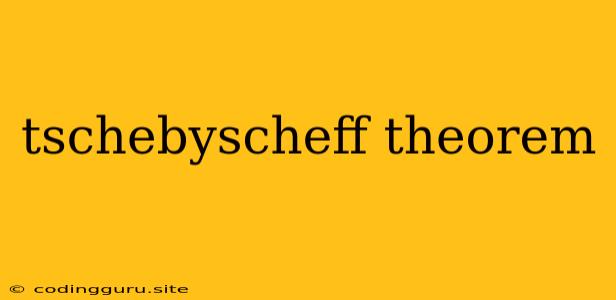What is the Tschebyscheff Theorem?
The Tschebyscheff Theorem, also known as Chebyshev's Inequality, is a fundamental theorem in probability theory that establishes a relationship between the probability of a random variable deviating from its expected value and its variance. It provides a powerful tool for bounding the probability of an event without needing to know the specific distribution of the random variable.
Understanding the Theorem
The theorem states that for any random variable X with finite mean (μ) and variance (σ^2), the probability of X deviating from its mean by more than k standard deviations is less than or equal to 1/k^2.
Mathematically:
P(|X - μ| ≥ kσ) ≤ 1/k^2
where:
- X: The random variable
- μ: The mean of X
- σ: The standard deviation of X
- k: Any positive number
Interpreting the Theorem
The Tschebyscheff Theorem essentially tells us that:
- The larger the value of k (the number of standard deviations away from the mean), the smaller the probability of the random variable deviating by that amount.
- No matter the distribution of the random variable, there's a bound on the probability of extreme deviations.
Applications of the Tschebyscheff Theorem
The theorem has various applications in statistics, probability, and related fields:
- Data Analysis: It helps analyze datasets and estimate the probability of extreme values.
- Quality Control: It helps determine acceptable tolerance limits for products.
- Risk Management: It assists in assessing the probability of significant losses or deviations from expected outcomes.
- Financial Modeling: It helps evaluate the risk associated with investments.
Example
Let's say you have a random variable representing the height of students in a school. The mean height is 1.65 meters, and the standard deviation is 0.1 meters.
Applying the Tschebyscheff Theorem, we can find the probability of a student's height deviating from the mean by more than 0.2 meters (2 standard deviations):
P(|X - 1.65| ≥ 0.2) ≤ 1/2^2 = 1/4
This means that the probability of a student's height being either less than 1.45 meters or greater than 1.85 meters is less than or equal to 25%.
Advantages and Limitations of the Tschebyscheff Theorem
Advantages:
- Universality: It applies to any distribution with finite mean and variance.
- Simplicity: It provides a simple and general bound for probabilities.
Limitations:
- Conservative: The bound provided by the theorem can be loose, especially for distributions that are not heavily skewed.
- No Information on Specific Distribution: It doesn't tell us the exact probability of a specific deviation, only an upper bound.
Conclusion
The Tschebyscheff Theorem is a valuable tool in probability and statistics that provides a universal bound for the probability of deviations from the mean. It offers a general understanding of the spread of data and helps us estimate probabilities without requiring specific information about the distribution. While it may not always provide the tightest bound, it serves as a useful starting point for analyzing and understanding the behavior of random variables.
